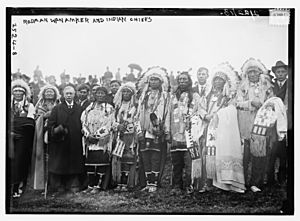Wanamaker expeditions facts for kids
The Wanamaker expeditions were a series of three trips led by Joseph K. Dixon in the early 1900s. These journeys aimed to visit and photograph Native peoples across the United States. The main sponsor for these expeditions was Rodman Wanamaker, who owned a large department store.
Contents
Why the Expeditions Happened
The idea for these trips came from Joseph K. Dixon. He was a writer and photographer. Rodman Wanamaker agreed to pay for Dixon's project, which Dixon called "the Rodman Wanamaker Expeditions to the Indians."
Dixon worked for Wanamaker's department store in Philadelphia. He was in charge of public relations. The Wanamaker store was founded in 1876 by Rodman's father, John Wanamaker. By the early 1900s, it was a very big store with many locations. The store was known for offering fun activities and entertainment, not just products.
At this time, many white Americans believed Native American cultures were disappearing. They became very interested in learning about them. There were also efforts to make Native Americans live more like white society. Dixon thought these expeditions would be good for Wanamaker's store and for the country. He presented himself as an expert on Native Americans.
The Journeys Begin
The first Wanamaker expedition took place in 1908. Dixon traveled to Crow Agency, Montana, with three photographers. The government's Bureau of Indian Affairs supported this trip.
Dixon carefully planned all the filming and photos. He wanted to show Native American life without any signs of white people. However, the images he created were often romanticized and made to look good for business. During this trip, they filmed a version of "The Song of Hiawatha." Dixon held auditions and chose many Native people to act in the film.
In 1909, a book called A Wanamaker Primer on the North American Indians was published. It contained some incorrect and biased ideas about Native Americans. It also described the defeat of Native Americans by white people as sad but unavoidable.
Later in 1909, Dixon went back to Crow Agency. He gathered about 100 Native chiefs to film "The Last Great Indian Council." They also reenacted the Battle of the Little Bighorn. Dixon made sure to record how he took his photographs.
The Citizenship Expedition
In February 1913, work began on a National American Indian Memorial. Dixon asked Franklin Knight Lane, who was a government official, for permission for another trip. Lane approved it.
In June 1913, Dixon started his "expedition of citizenship." He traveled with his son, Rollin, another photographer, John Scott, and James McLaughlin. An employee from Eastman Kodak also joined them. This trip was sponsored by Wanamaker's and the Pennsylvania Railroad. The railroad provided a special train car called Signet, which had a darkroom for developing photos.
At this time, Native Americans were not considered citizens of the United States. They did not gain this status until 1924 with the Indian Citizenship Act.
Important people like President Woodrow Wilson, former President William Howard Taft, and inventor Thomas Edison supported this expedition. Money for the trip also came from a group called the "Committee of One Hundred." This group included rich Americans like John D. Rockefeller and William Randolph Hearst.
The expedition traveled about 20,000 to 27,000 miles by train in about six months. They visited 89 different Native tribes. At each stop, they held a ceremony and raised an American flag. They also gave an American flag to every reservation they visited. The expedition carried a "Declaration of Allegiance" for Native people to sign. They also had recordings of the Commissioner of Indian Affairs and the President speaking. Not all tribes welcomed the Americans, especially the Hopi, Pueblo, and Navajo peoples.
What Came from the Expeditions
Dixon believed his "expedition of citizenship" marked a new beginning for Native American history. His films often showed Native Americans as a disappearing people.
The expeditions created thousands of photographs. The first two trips alone produced 4,600 photos. These were published in a book called The Vanishing Race and other places. They also produced about 50 miles of film. This film was used to make several movies, including "The Song of Hiawatha" and The Romance of a Vanishing Race. Later, Wanamaker gave over 300 talks about "The Song of Hiawatha" to more than 400,000 people. The book The Vanishing Race was printed for over 60 years.
At the Panama–Pacific International Exposition, the expedition's photographs won a gold prize. James McLaughlin, who was on the 1913 trip, said Dixon's methods were mostly for publicity. An article in the Society of American Indians's Quarterly Journal called Dixon's expeditions "the great advertising hoax." However, the 1913 expedition did help increase public support for Native American citizenship. Some tribes also welcomed Dixon's visit.


